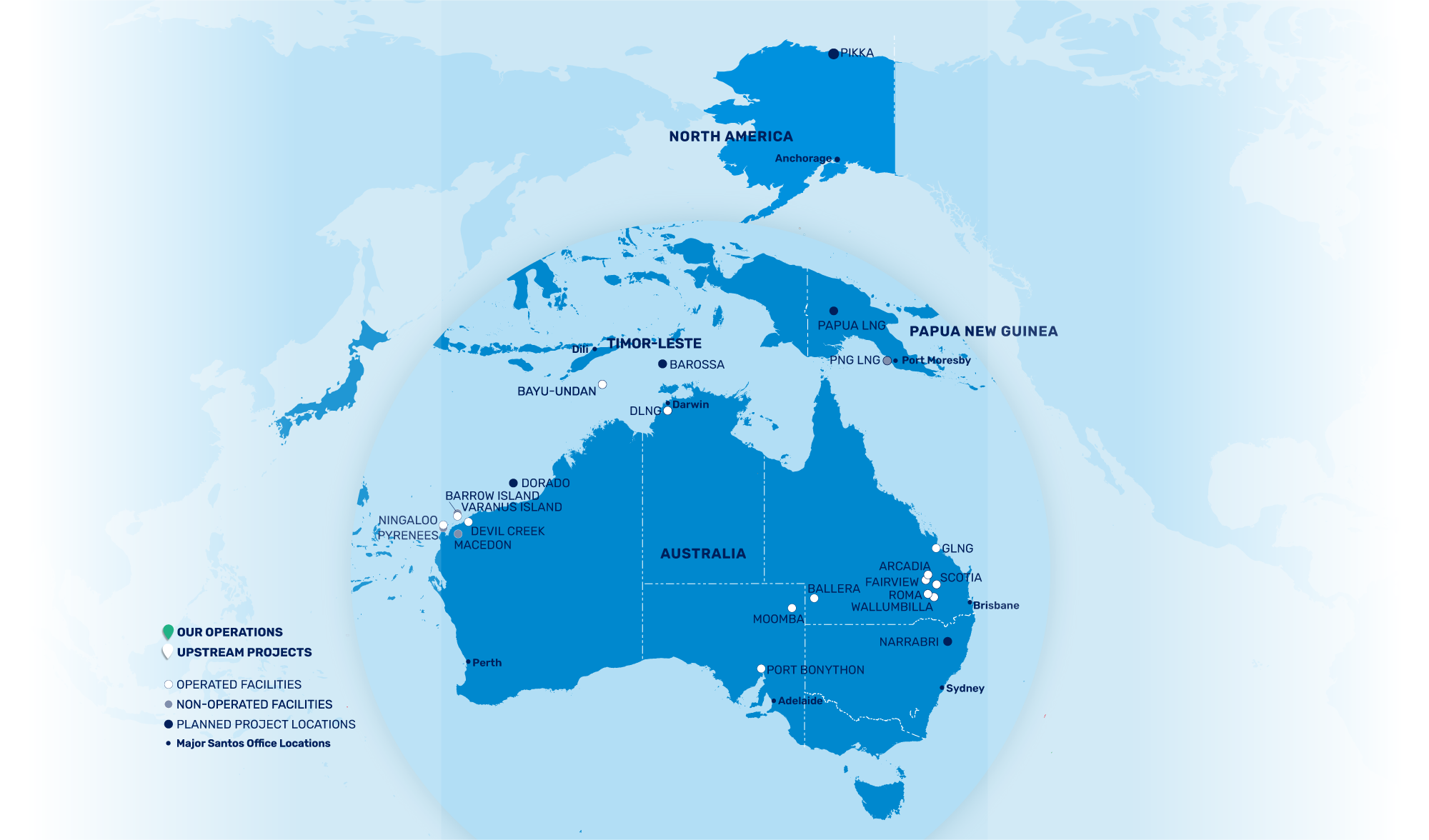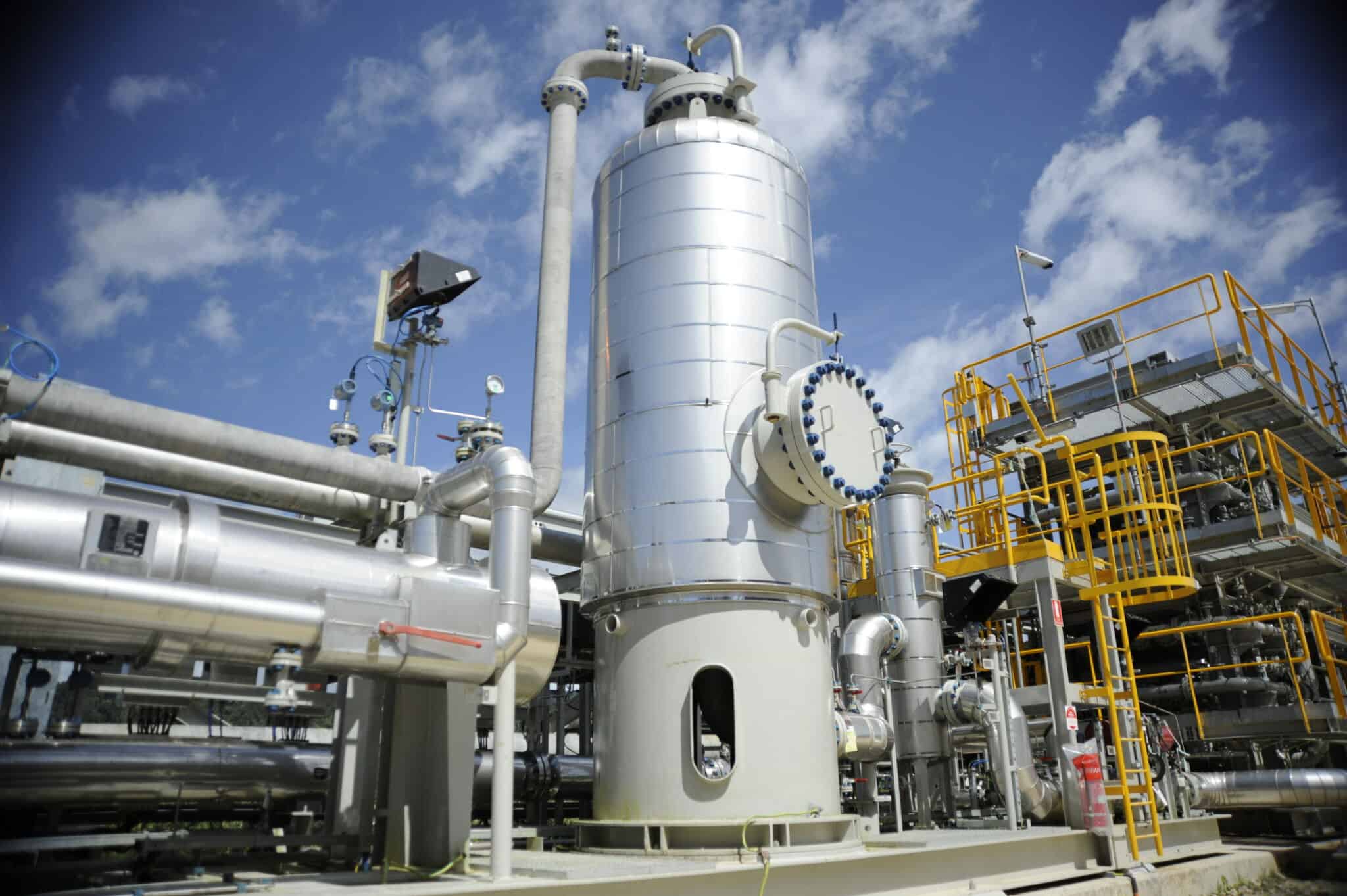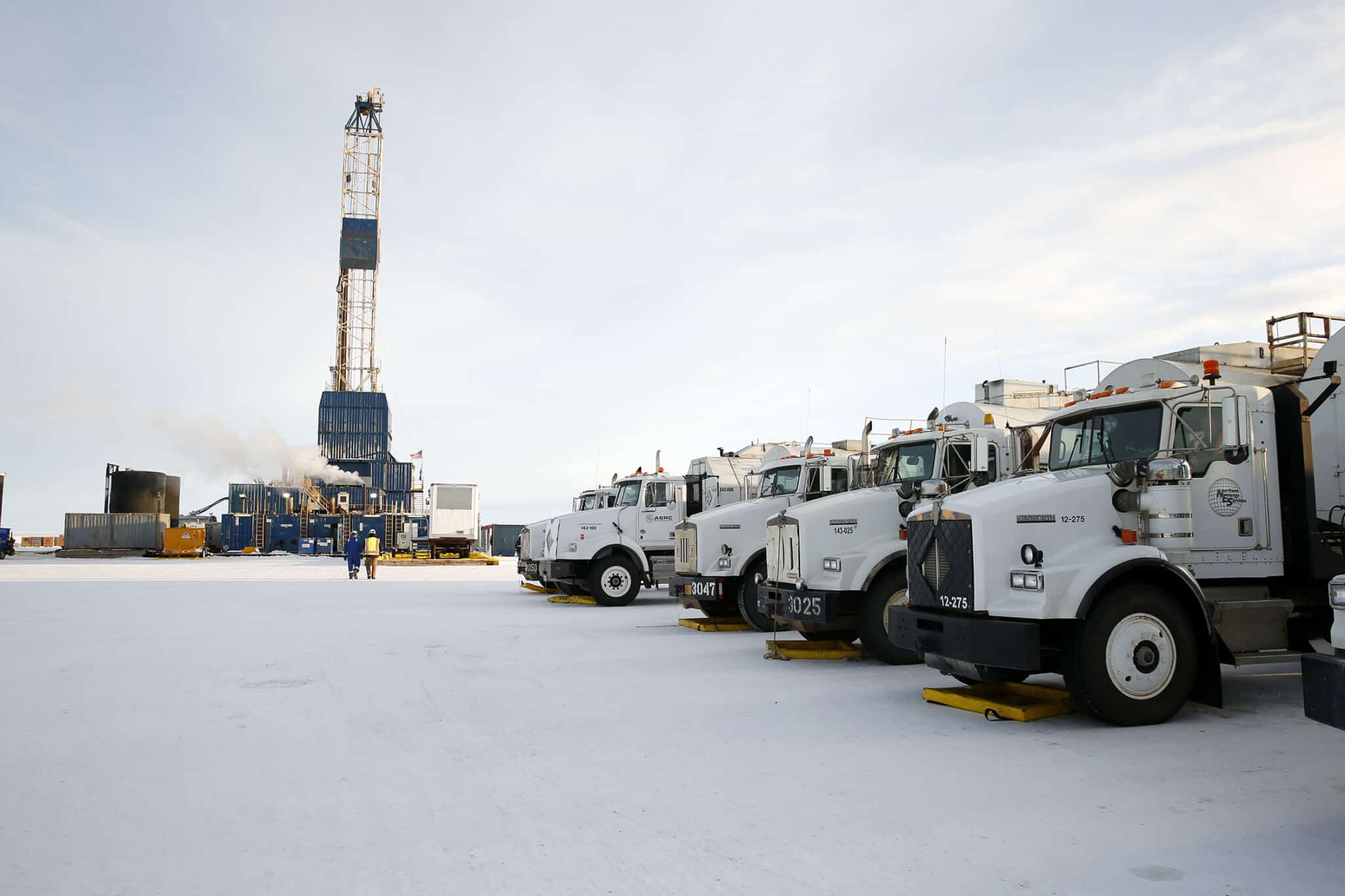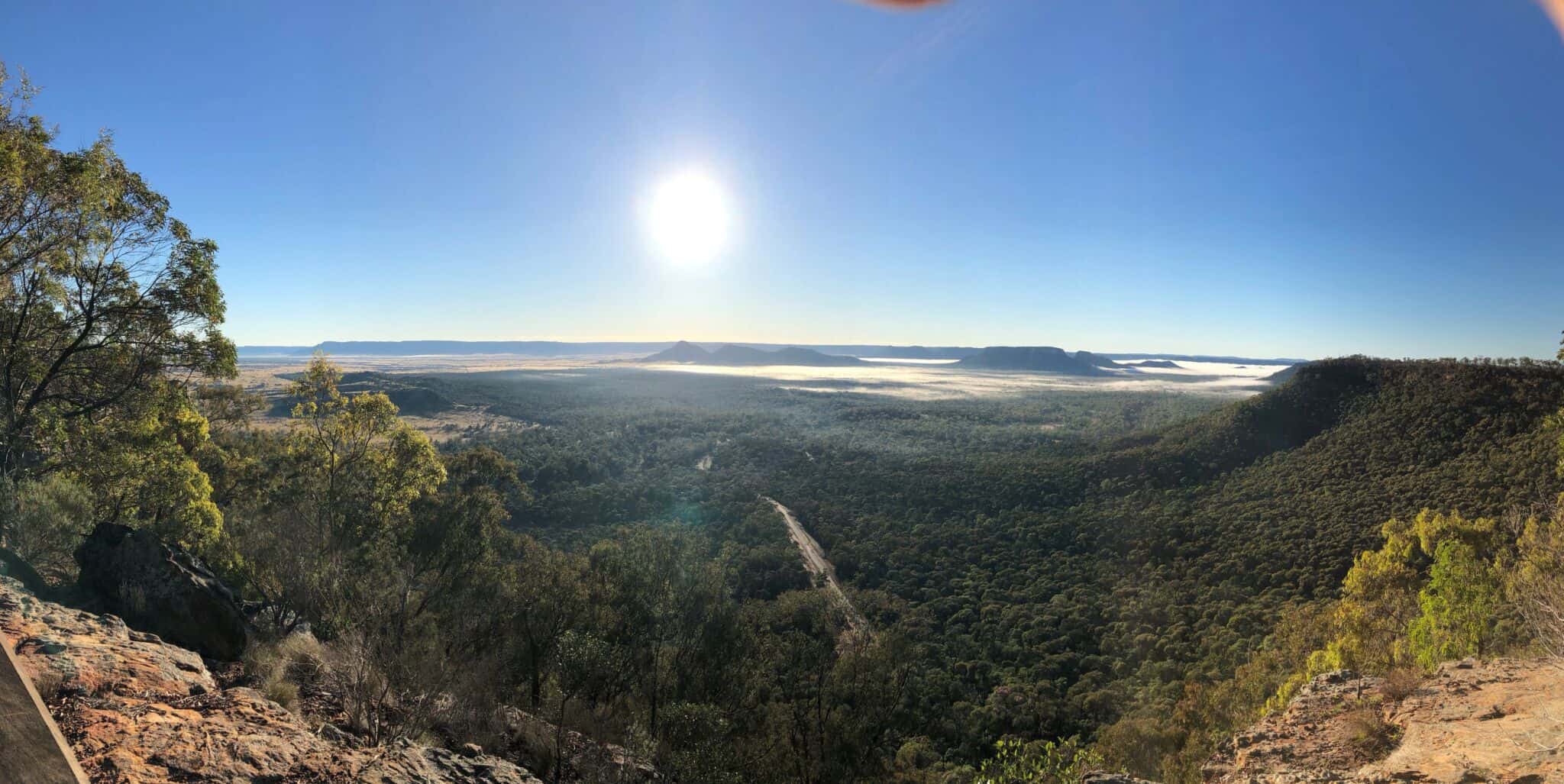Our Upstream Gas and Liquids business includes an Asian market-focused LNG business comprising three projects – Papua New Guinea LNG, Gladstone LNG, and Bayu-Undan and Barossa to DLNG – and two Australian domestic gas businesses (west coast and east coast).
Papua New Guinea LNG (PNG LNG)
Papua New Guinea
Santos has been a committed participant in Papua New Guinea since the 1980s, becoming a producer in 1998 through the SE Gobe oil project in the Gulf Province. Acquisition of a 24 per cent interest in PDL-1 in 1998 gave Santos access to a significant part of the giant Hides gas field and resulted in Santos becoming a foundation partner in the PNG LNG project. Following the company’s merger with Oil Search in December 2021, Santos’ overall interest in this project increased.
PNG LNG is an integrated development that includes gas production and processing facilities that extend from Hela, Southern Highlands, Western and Gulf provinces to Port Moresby. The facilities are connected by over 700 kilometres of onshore and offshore pipelines and include a gas conditioning plant in Hides and a two-train liquefaction and storage facility near Port Moresby.
LNG production began in April 2014 and since then, PNG LNG has been reliably supplying LNG to four long-term major customers in Asia.
Santos is positioned to grow its presence in PNG through PNG LNG backfill and expansion, including development of the P’nyang field, as well as standalone opportunities. The company is also a joint venture partner in the Papua LNG Project, which proposes to integrate its midstream development within PNG LNG.
Gladstone LNG (GLNG)
Queensland, Australia
With a large resource base in Queensland and a growing Asian demand for liquefied natural gas (LNG), Santos created the GLNG project in 2007, a pioneering project to convert natural gas, including coal seam gas from the Bowen and Surat Basins, into LNG for export to Asia.
GLNG is a joint venture between Santos and three of the world’s leading energy companies: PETRONAS from Malaysia, Total from France and KOGAS from South Korea.
The project involved the development of gas fields in the Bowen and Surat Basins, the construction of a 420-kilometre underground gas transmission pipeline to Gladstone and a two-train liquefaction and storage facility on Curtis Island in Gladstone. GLNG sells approximately two cargoes of LNG per week and has been supplying two long-term Asian customers since the first cargo was shipped in October 2015.
As upstream operator, Santos is focused on building gas supply through upstream development, seeking opportunities to extract value from our infrastructure and driving efficiencies.
Find out more about GLNG operations
Bayu-Undan and Barossa to DLNG
Offshore Timor-Leste, and offshore and onshore Northern Territory, Australia
Located at Wickham Point, Darwin LNG is a single train liquefaction and storage facility that started production in 2006. The Bayu-Undan field, which supplies gas to the plant via a 26-inch subsea pipeline, is located approximately 500 kilometres northwest of Darwin in Timor-Leste offshore waters. The facility includes a central production and processing complex with a floating production, storage and offloading vessel for condensate and LPG products and an unmanned wellhead platform. Santos operates both the Darwin LNG plant and Bayu-Undan facility.
When Bayu-Undan ceases production, the Barossa gas field will be the source of gas to backfill Darwin LNG, with first gas production expected in the first half of 2025. In March 2021, Santos announced the Final Investment Decision on the Barossa Gas Project, which is located 300 kilometres north of Darwin.
The Darwin LNG plant has the capacity to produce approximately 3.7 million tonnes of LNG per annum. Barossa is a world-class new LNG supply project and will give Santos and Darwin LNG a competitive advantage in a tightening global LNG market. At the time of Final Investment Decision, the project represented the biggest investment in Australia’s oil and gas sector since 2012.
Development of the large, discovered Barossa resource will extend the operating life of DLNG for an additional 20 years, thereby continuing to help meet future global demand for natural gas and contributing significant income and employment opportunities for Australia.
Australian Domestic West Coast
Santos is the second biggest producer of domestic gas in Western Australia and has been operating in the west since its first offshore discovery in the Carnarvon Basin, in the early 1980s.
The company also has a strategic infrastructure position in WA, with interests in three of the state’s major domestic gas plants, at Varanus Island, Devil Creek and Macedon.
Gas, condensate and oil from the offshore John Brookes, Harriet and Spar-Halyard fields is piped to the Santos-operated Varanus Island processing facility. The sales gas is then transported to mainland WA via two 100-kilometre pipelines, where it is supplied to major mining and industrial customers. Oil and condensate are stored on the island and transferred to tankers for direct export.
Gas and condensate from the offshore Reindeer field are transported to the Santos-operated Devil Creek processing plant, near Karratha, via a 105-kilometre pipeline. Gas from the offshore Macedon field is piped to the Macedon Domestic Gas Plant near Onslow. Sales gas from both facilities is compressed and sent to the WA domestic gas market.
The Van Gogh oil project comprises three offshore fields – Van Gogh, Coniston and Novara – serviced by the Floating Production Storage and Offloading (FPSO) vessel, Ningaloo Vision, operated by Santos and located approximately 40 kilometres north of the North West Cape.
The Pyrenees oil project, comprising the Crosby, Ravensworth and Stickle offshore fields, and serviced by the Pyrenees Venture FPSO vessel, is stationed approximately 25 kilometres north off the North West Cape.
Santos will continue to pursue near-field exploration opportunities and build on its position as one of the leading suppliers of gas to the WA market.
Australian Domestic East Coast
Santos’ domestic east coast portfolio includes the Cooper and Eromanga Basins as well our non-operated eastern Queensland production.
Spanning the borders of northeast South Australia and southwest Queensland, the Cooper and Eromanga Basins house Australia’s largest onshore oil and gas field development.
Santos discovered the first commercial hydrocarbon resource (natural gas) at Gidgealpa-2 in 1963 and first oil in 1970. The Cooper Basin now produces natural gas, ethane, gas liquids and crude oil.
The Cooper Basin asset is strategically important, housing key infrastructure at Moomba in northeast South Australia. This Santos-operated infrastructure is integral to the processing and transportation of natural gas and ethane around the east coast of Australia, supported by substantial underground storage facilities suitable for natural gas, ethane and carbon dioxide.
Natural gas liquids recovered at the plant are sent together with stabilised crude oil and condensate via a 659 kilometre pipeline to Port Bonython, South Australia, for further processing. Products including naphtha, crude oil, propane and butane are sold to domestic customers via the road tanker loading facilities and export customers through the ship loading facility.
Santos’ strategy in the Cooper Basin is to deliver value by being a low-cost business, increasing reserves, investing in new technology to lower development and exploration costs, reducing emissions and increasing utilisation of infrastructure.
Dorado
Offshore Western Australia, Australia
Santos’ Dorado oil field is a liquids-rich, low CO2 resource located in the Bedout Basin, approximately 150 kilometres north of Port Hedland in petroleum permit WA-437-P.
Dorado is an integrated oil and gas project which is planned to be developed in two phases. The initial development involves the production of oil and condensate through a floating production, storage and offloading (FPSO) vessel. Gas will be reinjected in the initial phase to enhance oil and condensate recovery, followed by a planned future phase of gas production to backfill Santos’ domestic gas infrastructure in WA.
Dorado is a very low CO2 reservoir with approximately 1.5 per cent CO2 and reinjection of gas in the initial phase will make it one of the lowest emission intensity oil projects in the region.
Narrabri
New South Wales, Australia
The Narrabri Gas Project in New South Wales, Australia is located on state land in a section of the Pilliga National Park, set aside by the NSW Government for uses including logging and extractive industries.
Santos’ Narrabri Gas Project is expected to supply New South Wales homes, small businesses, major industries and electricity generators with up to 50 per cent of the state’s natural gas needs, bringing significant economic benefits to Narrabri and the surrounding region.
The Narrabri Gas Project involves the production of natural gas through the progressive development of up to 850 wells connected into processing facilities south of Narrabri at Leewood and Bibblewindi. The Narrabri Gas Project will also include the construction of surface facilities and supporting infrastructure.
Santos has recently acquired the route for the Hunter Gas Pipeline. The proposed underground pipeline route passes close to the Narrabri Gas Project.
Santos is working in partnership with landholders, local councils and communities the pipeline will traverse to deliver new gas supply to domestic markets and maximise social and economic benefits of both the Narrabri Gas Project and the Hunter Gas Pipeline.
Papua LNG
Papua New Guinea
The Papua LNG Project will see the development of the Elk-Antelope gas field located in PRL 15 license in the Gulf Province, onshore Papua New Guinea.
The Papua LNG project is well positioned to contribute to growth in LNG supply worldwide, especially for customers in Asia seeking to decarbonise from coal to gas, in line with our strategy to lower global greenhouse gas emissions.
The Papua LNG joint venture is committed to developing a landmark project in terms of sustainability, biodiversity, and low carbon emissions. Specifically, the project will incorporate a carbon capture and storage scheme for the fields’ native CO2, which will be reinjected into the reservoirs.
In March 2023, joint venture partners announced they had launched fully-integrated front-end engineering and design (FEED) for the project.
Barossa
Offshore Northern Territory, Australia
The Santos-operated Barossa Gas Project, located in Commonwealth waters approximately 285 kilometres offshore north-northwest from Darwin in the Northern Territory, is an offshore gas and condensate project that proposes to provide a new source of gas to the existing Darwin liquified natural gas (DLNG) facility in the Northern Territory.
The Barossa Gas Project comprises a floating production, storage and offloading (FPSO) facility, subsea production system, supporting in-field subsea infrastructure and a gas export pipeline. The FPSO facility will separate the natural gas and condensate extracted from the field with the dry gas transported via the export pipeline for onshore processing.
Pikka
Alaska, United States of America
The Nanushuk play in the Pikka Unit represents one of the largest conventional oil discoveries made in the United States in the last 30 years, and the Pikka Phase 1 project is the most significant development on Alaska’s North Slope in more than 20 years.
In August 2022, Santos, as operator of the Pikka Unit joint venture, announced a final investment decision (FID) had been taken on the project.



